Tampa I (Coast Guard Cutter)
1912–1918
A city in Hillsborough County, Fla.
I
(Coast Guard Cutter: displacement 1,181 tons; length 190'; beam 32'6"; draft 14'1"; speed 13 knots; complement 70; armament 3 six-pounder guns; class Unalga)
Miami, a cutter built for the Revenue Cutter Service, was authorized on 21 April 1910 and was laid down on 10 August 1911 by the Newport News (Va.) Shipbuilding & Dry Dock Co.; launched on 10 February 1912; and sponsored by Miss Mary Barnes Richardson, daughter of Rep. William Richardson of Alabama, senior member of the House Committee on Interstate and Foreign Commerce. Miami conducted her trials off Hampton Roads, Va. on 27 April 1912, then was accepted by the Revenue Cutter Service on 8 May. The following day, the cutter cleared her building yard and steamed up the Chesapeake Bay, arriving at the Revenue Cutter Service depot at Arundel Cove, Md., soon thereafter to fit out. She was placed in commission at the depot at Arundel Cove, on 19 August 1912, Capt. Aaron L. Gamble, RCS, in command.
After her commissioning, Miami underwent wireless and other equipment installation until 16 October 1912. That same day, she received movement orders to proceed to the Washington (D.C.) Navy Yard, Newport News, then to the Norfolk Navy Yard, Portsmouth, Va. She departed the depot on 19 October, two days later her orders were amended and she received instructions to proceed to Key West, Fla., and assume her station there. She arrived at the Washington Navy Yard to coal on 21 October. Departing the next day, she steamed to Newport News and arrived on the 24th. She shifted to the Norfolk Navy Yard on 28 October and then departed two days later for Florida. She reached her station at Key West on 1 November and would operate from this location on routine law enforcement patrols. The cutter’s cruising sector consisted of the waters from Tampa, Fla. on Florida’s Gulf coast down through the Florida Keys and around to the state’s Atlantic coast. On 23 November, she received orders that her cruising sector was extended farther north to Fernandina, Fla. She conducted her patrol routine through the end of 1912 and into the following months.
Miami received orders on 20 January 1913 to participate in Mardi Gras festivities at Tampa, Fla. on 4 February. With this done, she resumed her routine duties in her assigned cruising district. On 28 March, the revenue cutter received orders dispatching her immediately to New York, N.Y. Upon her arrival, she was to report to Commander, New York Division. She was also to be prepared to be off station for three months. The following day, she was assigned to patrolling the ice fields in the waters of the Grand Banks off Newfoundland. On 31 March, she cleared Key West, bound for New York. She arrived on 5 April and undertook preparations to relieve her fellow revenue cutter, the derelict destroyer Seneca on International Ice Patrol duty. This patrol was established in the wake of the White Star liner RMS Titanic striking an iceberg late on 14 April and sinking in under three hours at 2:20 a.m. on 15 April 1912.
Miami cleared New York on 10 April 1913 and proceeded to Seneca’s relief. She reached Halifax, Nova Scotia (N.S.), on 5 May. Eight days later, on 13 May, she stood out from Halifax and patrolled her assigned sector until 31 May, when she was relieved by Seneca. She arrived back at Halifax on 3 June and her patrol was discontinued. While still at Halifax, she received orders on 27 June dispatching her to search a grid for the presence of icebergs. She was to discontinue the search if no ice was found and then return to New York. She cleared Halifax on 5 July, having observed no ice, the cutter made her return to New York on 8 July. The following day, she entered drydock at the New York Navy Yard, Brooklyn, N.Y. That same day she received orders to make her return to Key West upon the completion of her yard work. Miami undocked and clearing the Navy Yard on 22 July, she raised the depot at Arundel Cove on the 24th. The following day, she stood out from Arundel Cove and returned to Key West on 30 July. The cutter then spent the remainder of the year operating from Key West and cruising in her designated cruising sector in the enforcement of navigation laws.
With the New Year, Miami continued to patrol the waters off the Florida coast. On 14 February 1914, she received orders to proceed to Tampa to participate in the Gasparilla Carnival (21–24 February). The cutter arrived on 19 February and performed her duties as directed. After filling her coal bunkers on 7 March, she received orders to proceed to New York and again report to Commander, New York Division. While there, the cutter was to undergo any necessary repairs in advance of steaming back to the Grand Banks in order to relieve Seneca. She cleared Key West on 10 March and reached New York on 15 March. The following day she entered drydock and remained there undergoing overhaul and maintenance until undocking on 1 April.
Miami got underway again on 4 April 1914, and having cleared New York, reached Halifax on 7 April. Five days later, on 12 April, she cleared Halifax to conduct her patrols on the Grand Banks. Over the following weeks the cutter conducted ice patrols except for when she stood in to Halifax (4–12 May and 3–11 June). The cutter, on 19 June, communicated with higher authorities and recommended that the patrol should be concluded for the season. Orders to that effect were ordered and the patrol was subsequently discontinued on 2 July. Miami stood out from Halifax on the 7th. Bound for Arundel Cove, she arrived at the depot on 11 July. The cutter then underwent repairs into August. During this time, war broke out in Europe and on 6 August, the ship’s orders relative to international derelict destruction were suspended. She was then to resume her station at Key West upon the completion of her repairs.
Miami received orders on 11 August 1914 directing her to proceed to a return to Key West in the relief of the cutter Windom. She was to resume her patrol duties based from that station. In that capacity, she was to place special emphasis on the enforcement of fishing regulations. With these instructions, she departed Arundel Cove on 17 August. The following day she arrived at Hampton Roads and relieved the revenue cutter Onondaga on her neutrality patrol duty at the entrance to Hampton Roads. Two days later, on 20 August, she resumed her transit to Key West, where she reached on 25 August. Back on station, she conducted her patrolling and law enforcement duties through the end of the year and into 1915.
Miami was still assigned to and conducting routine patrols based from Key West on 1 January 1915. She, however, received orders on 23 January to participate again in Tampa’s Gasparilla Carnival (12–16 February). The following day, 24 January, she received notification that she was to serve again on the International Ice Patrol. Shortly thereafter, on 28 January 1915, the U.S. Life-Saving Service and the Revenue Cutter Service were merged to form the United States Coast Guard. Miami arrived for her duty at Tampa on 10 February. While in port, she overhauled her chains, steering gear, and other like equipment. After completing her duties at Tampa, she returned to Key West. While there on 3 March, she was again assigned to Commander, New York Division, for ice patrol duties. She departed on 10 March and raised New York on 14 March. Entering the New York Navy Yard for pre-deployment maintenance and overhaul, the cutter received orders on 22 March, directing that she proceed as soon as “practicable” after 1 April to Halifax in order to relieve Seneca by 16 April.
Miami cleared the New York Navy Yard on 5 April 1915 and reached Halifax on the 8th. She stood out through the Eastern Passage on 14 April and relieved Seneca on the Grand Banks. Over the following weeks, she conducted ice patrols with the exception of her time in Halifax for refueling, replenishment, and maintenance (5–16 May). Seneca relieved the cutter on 11 June, and proceeded in to Halifax. Departing two days later, she transited via Boston (19 June) and arrived at New York on the 21st. Commander, New York Division, on 28 June, directed Miami to proceed to Key West and resume her regular station. She cleared New York on 14 July. En route she stopped at Hampton Roads to take on a load of mines (15 July) before proceeding to Jacksonville, Fla. (19 July) and reaching her station at Key West on 24 July. She resumed her patrolling routine in the waters off Florida in the following months. During this time she made a visit to Havana, Cuba (23–25 October). The cutter then continued to cruise her designated sector through the year’s end.
Miami, still based from Key West on 1 January 1916, received orders on 13 January instructing her to participate in the celebrations of the South Florida Fair and Gasparilla Carnival (4–12 February). Before engaging in those duties, however, the cutter was re-named Tampa on 1 February. After departing Tampa upon the completion of her duties there, the cutter resumed her patrolling. She was at Fernandina on 9 March, when she departed. Bound for New York, she was to return to the ice patrol. Making her arrival at New York on 12 March, she underwent pre-deployment preparations. The cutter departed New York on 12 April and made her way to her Grand Banks patrol sector. She remained on this duty through 8 July, when she departed Halifax. Making her way to New York, she arrived on 11th.
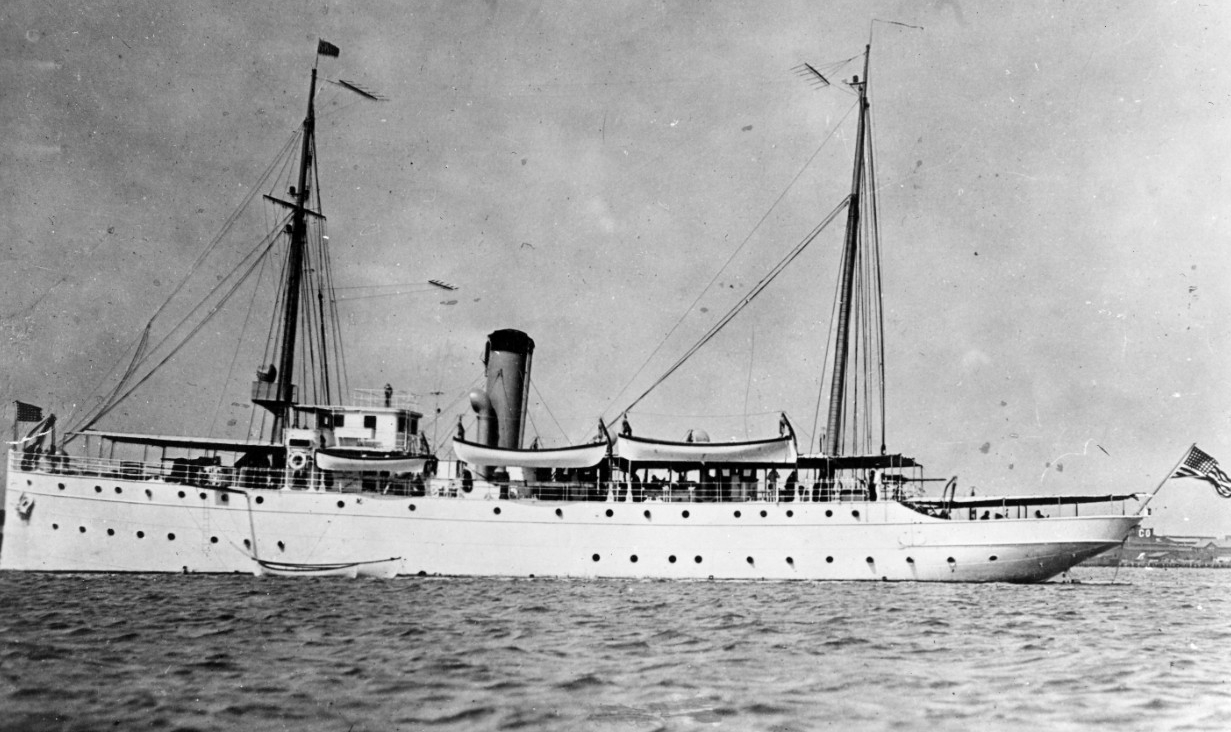
Tampa, after a time at New York, arrived at Hampton Roads on 28 July 1916 and remained there a month before shifting to Newport News on 28 August. With her departure from the Chesapeake Bay, she steamed to Charleston, S.C., arriving on 10 September. The cutter then proceeded to return to her patrol sector in advance of making her return to her home station at Key West on 24 November. She then continued her patrolling and law enforcement duties in her designated sector between Tampa and Fernandina. On 21 December, she received orders to participate again at both the South Florida Fair and Gasparilla Carnival in 1917.
Tampa, on 1 January 1917, was still based at Key West from whence she conducted her patrolling duties. She participated in the South Florida Fair and Gasparilla Carnival (2–10 February) and then proceeded to Miami, where she patrolled the Third Annual Motorboat Regatta (15–17 February). After again resuming her patrol cruising, she received orders on 13 March to patrol the St Petersburg (Fla.) Yacht Club Races (27–28 March).
As Tampa was performing these duties, however, tensions between the U.S. and Germany were increasing due to the latter’s resumption of its unrestricted submarine warfare campaign. Anticipating the likelihood of war with Germany, Captain Commandant Ellsworth P. Bertholf, USCG, issued Confidential Order No. 2, “Mobilization of the U.S. Coast Guard When Required to Operate as a Part of the Navy” on 22 March 1917. With the U.S. declaration of war on 6 April, control of the Coast Guard transferred from the Treasury Department to the Navy Department. The Navy was to exercise operational control and provide logistical support including repairs and orders for fuel, oil, and supplies, while the Coast Guard was administratively responsible for its servicemembers.
Tampa lay at the city for which she was named when she was transferred to the Navy on 6 April 1917. That same day, Capt. Charles Satterlee, USCG, reported to the Commandant, 7th Naval District, at Key West (Base No. 16), that his command stood in readiness for duty. Tampa awaited the arrival of the cutter Tallapoosa and on the morning of 9 April joint forces from both cutters seized the Austro-Hungarian steamer Borneo and then turned the vessel over to the Collector of Customs for Tampa. Returning to Key West on 10 April, Tampa conducted patrols, trained naval reservists, and cooperated with the other vessels based from that station through 14 July 1917. On this date she departed for the Chesapeake Bay and arrived at Lynnhaven Roads, Va. (18 July) before returning to Key West on 22 July. She then went to sea (24–28 July) before again returning to Key West. On 30 July, she cleared the Florida Keys and steamed to the Boston (Mass.) Navy Yard. Arriving on 4 August, she entered the drydock to undergo preparations for distant service. During this time, she received heavier armament, trading her three six-pounders for two 3-inch and two 4-inch guns, a pair of machine guns and depth charge throwers and racks.
After these preparations at Boston Navy Yard, Tampa cleared on 15 September 1917 and steamed to the New York Navy Yard. Arriving on 19 September, she reported for duty to the commanding officer of Paducah (Gunboat No. 18). That same day, she shifted to Gravesend Bay, N.Y. Ordered to duty overseas, the cutter departed on 29 September in company with Paducah, the collier Sterling, patrol vessel Hubbard (S. P. 416), and five French-manned, American-made 110-foot submarine chasers in tow. The force’s first leg was to Halifax (Base No. 23) (3–6 October) and then they proceeded to Ponta Delgada, Azores (Base No. 13) (17–21 October). While en route on 14 October, the subchasers detached from their tow and proceeded under their own power. Clearing Ponta Delgada, Tampa and Paducah reached the British Crown Colony at Gibraltar (Base No. 9) on the 27th.
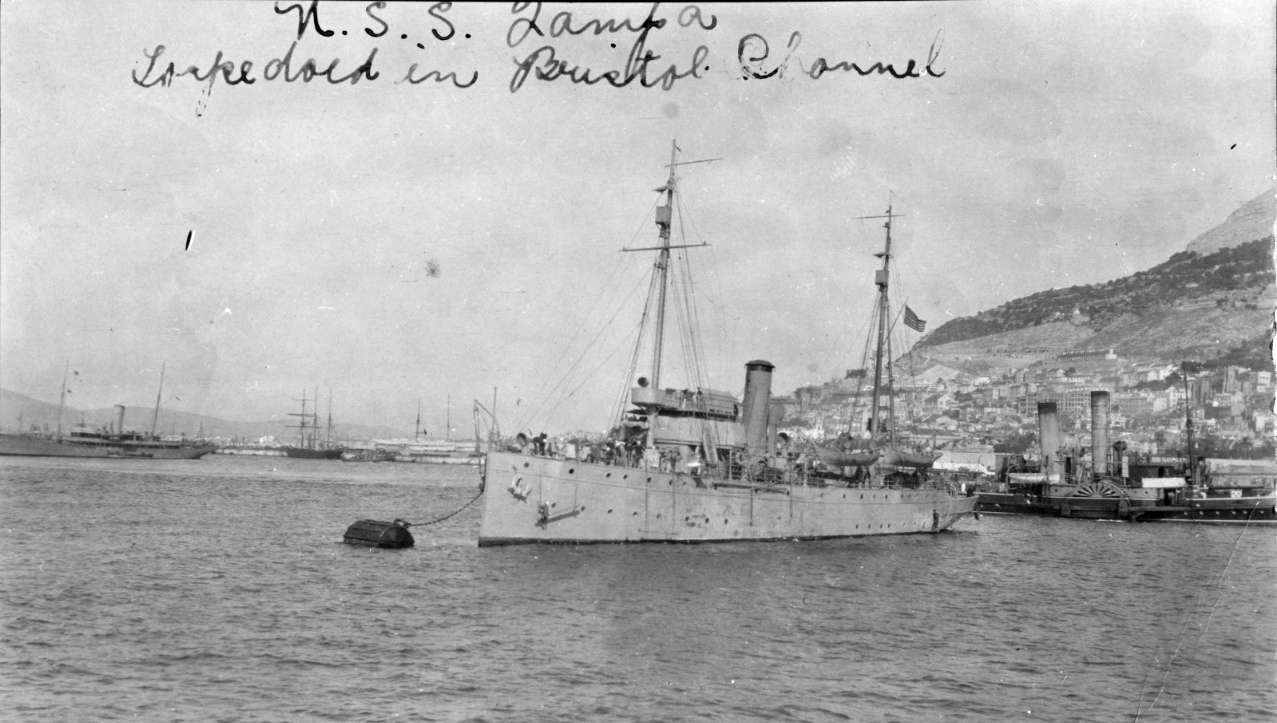
Upon her arrival at Gibraltar, Tampa was assigned as an ocean escort to Squadron One of the Patrol Forces commanded by Rear Adm. Albert P. Niblack. The other ships in the squadron would include fellow Coast Guard cutters Algonquin, Manning, Ossipee, Seneca, and Yamacraw and the Navy vessels Sacramento (Gunboat No. 19), Birmingham (Scout Cruiser No. 2), Wheeling (Gunboat No. 14), and Chester (Cruiser No. 1).
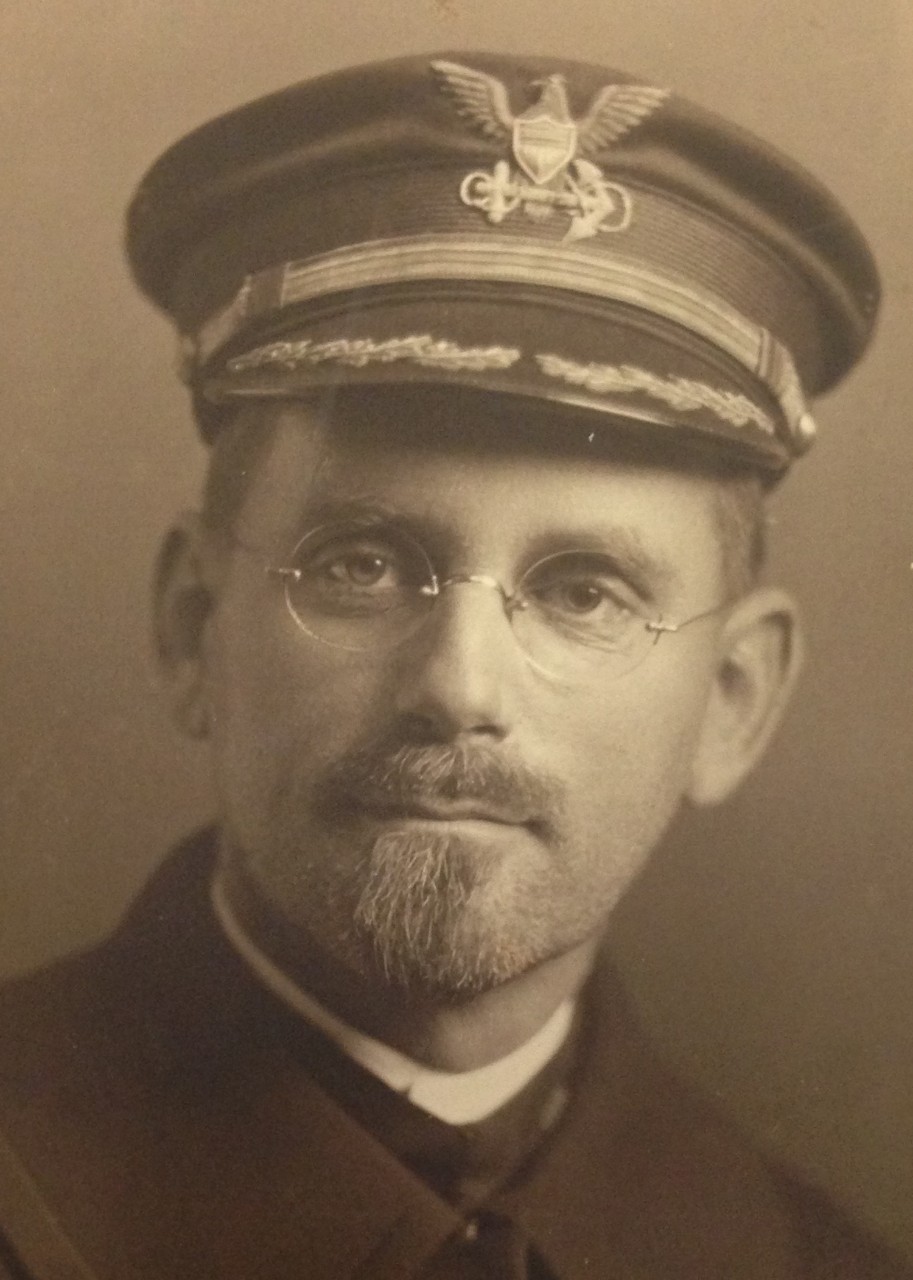
A week after her arrival, Tampa was underway on 4 November 1917, escorting her first convoy, HG 27, 21 ships outbound from Gibraltar and bound for the British Isles. She arrived at Pembroke Dock, Wales on 14 November. She remained until 17 November, when she departed Milford Haven, Wales, escorting the 13 ships of convoy OM 25, bound for Gibraltar. At 7:20 a.m. on 19 November, the British steamer Suzanne Marie was attacked by gunfire from a U-boat on the surface. Tampa proceeded at high speed to her assistance and fired five rounds at what she believed was the diving U-boat, with negative results. Two days later, two of the merchant vessels in the convoy collided and were abandoned by their respective crews. Tampa picked up 36 survivors from the steamer Bilibuster. Afterward, the cutter remained on scene and coordinated the towing of the damaged ships in to port. With that accomplished, she rejoined the convoy. On 24 November, the steamer Orangemoor hoisted the submarine warning signal, and the cutter’s crew went to general quarters. Though the U-boat was not seen, the cutter fired 21 rounds on the boat’s suspected position with negative results. Afterward, the convoy continued in toward its destination and arrived at Gibraltar on 25 November without further incident.
Tampa was again underway on 7 December 1917, clearing Gibraltar in company with the 13 vessels of convoy HG 36. Bound for Britain, the convoy was intercepted on 14 December by the additional escorts as it transited the “danger zone” around the British Isles. The convoy then encountered a heavy gale (16–17 December). She then parted with the convoy and stood in to Devonport, England, on 18 December. She remained in port until Christmas Day, when she sortied to rendezvous with the 24-ship convoy OF 18, outbound from Falmouth, England, and headed for Gibraltar. Shortly after joining the convoy on the 26th, two separate explosions on two separate ships were observed in quick succession while the convoy stood nine miles south of Dodman Point. The British steamers Benito and Tregenna were torpedoed and sunk by UB-57 (Kapitänleutnant Otto Steinbrinck commanding). Tampa continued with her charges and the danger zone escort parted from the convoy on 28 December. Proceeding onward, the convoy reached Gibraltar on 3 January 1918.
Within the fortnight, on 16 January 1918, Tampa sortied from Gibraltar escorting convoy HG 46. The convoy’s 16 ships were bound for Devonport and arrived without incident on 25 January. She was again underway on 4 February intercepting convoy OF 23 outbound from Falmouth. She and her fellow escorts conveyed the 10 ships in to Gibraltar on 11 February. She was again bound for Britain on 17 February. While en route on the 21st, one of the armed merchant vessels in the 16-ship convoy mistook Tampa for the enemy in the mist and fired three rounds at the ocean escort. The shots, however, missed and Tampa was unharmed and raised Devonport on 26 February.
Tampa and her fellow escorts rendezvoused with convoy OF 27 out of Falmouth on 8 March 1918 and brought the 14-ship convoy in to Gibraltar without loss a week later. Underway again on 17 March, Tampa and her consorts shepherded convoy HG 61 in to the British Isles. Tampa steamed into the Irish Sea and arrived at Liverpool, England, on 25 March. After clearing Liverpool, Tampa escorted convoy OM 58 and its 25 merchantmen from Milford Haven to Gibraltar (31 March–9 April).
The cutter stood out from Gibraltar on 18 April 1918 as an escort for convoy HG 69. This 39-ship convoy steamed toward Britain. After the convoy broke up, Tampa continued escorting a contingent in to the Mersey and Liverpool, arriving on 27 April. Quickly turning around, Tampa served as an escort for convoy OM 66 outbound from Milford Haven. Joining the convoy en route, Tampa escorted the 31 ships in to Gibraltar on the 11th. During her next convoy, her ill-fated 13th, Tampa sortied on 16 May to escort convoy HG 76. While en route on 21 May, there was a premature detonation from gun no. 2, resulting in a mortal wound to one of the ship’s coxswains who died of his wounds the following day. When the cutter reached Devonport on 25 May, the body was landed and prepared for burial. This death prompted the assignment of a Navy surgeon to the ship's complement.
Tampa stood out from Devonport and intercepted convoy OF 38, outbound from Falmouth, on 4 June 1918. A convoy of just 17 ships, it arrived without loss at Gibraltar on 10 June. Two days later, the cutter was again underway. Clearing Gibraltar, she intercepted convoy HE 13 which had departed Port Said, Egypt, on 4 June. Having made its way through the Mediterranean, the convoy was joined by Tampa and the other escorts on 12 June as it steamed toward Liverpool. The escorts conveyed the 17 ships into their destination, arriving on 18 June. Tampa again steamed down the Mersey and out into the Irish Sea and met convoy OM 80 outbound from Milford Haven on 29 June. Shortly after affecting link-up, another escort reported sighting a periscope. The sighting ship opened fired and the submarine submerged, not to be detected again. The convoy continued its transit and 26 ships reached Gibraltar without loss on 6 July.
Tampa cleared Gibraltar as escort for convoy HG 91 on 15 July 1918. While en route, the French merchant ship Argenfels reported that a torpedo passed her stern, but no further evidence of a U-boat was detected. While the convoy’s destination was Portsmouth, England, Tampa parted with the convoy and steamed in to Milford Haven. During her stay there, mounts for depth charge throwing “Y-guns” were installed along with depth charge projectors and racks. Clearing Milford Haven on 4 August, she escorted the 30-ship convoy, OM 89 in to Gibraltar on 11 August. With the completion of this escort mission, Tampa entered the dry dock at the Gibraltar yard and underwent much needed overhaul through 15 September. The day after she cleared the dry dock, 16 September, she was awarded a pennant for outstanding service as an ocean escort.
Tampa in company with her fellow escorts departed Gibraltar with the 32-ship convoy HG 107, bound for Liverpool, on 17 September 1918. The convoy proceeded without incident beyond Cornwall and into the Irish Sea. During the late afternoon of 26 September, Tampa parted company with the convoy as she was in need of refueling. Ordered to put in to Milford Haven, she proceeded independently toward her destination. At 7:30 p.m., as she steamed toward the Bristol Channel, UB-91 (Kapitänleutnant Wolf Hans Hertwig) spotted the ocean escort and, according the U-boat’s war diary entry, dived and maneuvered into an attack position. From a range of about 550 meters, UB-91 fired one G6AV torpedo with special attachment from her stern torpedo tube at 8:15 p.m. Minutes later, the warhead detonated on Tampa’s port side amidships, throwing up a huge, luminous column of water. Two minutes later, the U-boat was shocked by a second detonation, most likely caused by Tampa's depth charges reaching pressure fuse depth, as the cutter sank. All on board the cutter, 111 Coast Guard officers and men, 4 Navy sailors, and 14 British passengers were lost.
UB-91 resurfaced at 8:25 p.m. to look for debris and bodies, but found nothing. When Tampa failed to report at the expected time, a British seaplane and two Royal Navy PC boats were dispatched in search of her the following day. The seaplane was the first to spot an eight square mile debris field. Eventually, Davis (Destroyer No. 65), Stockton (Destroyer No. 73), and Wilkes (Destroyer No. 67) based from Queenstown [Cobh], Ireland (Base No. 6) confirmed the wreckage. Search and rescue efforts over the succeeding three days turned up some flotsam, identified as having come from the overdue cutter and a single body, subsequently identified from an identification tag found in his uniform pocket. The remains, however, were in such poor condition that it was determined that they should be buried at sea. Three additional bodies were later recovered, two from a beach near Lamphey, Wales, and the other at sea by a British patrol boat.
The sinking of Tampa with all of those on board was the single greatest combat loss for the Navy in World War I. Tampa was stricken from the Navy list as of the date of her sinking, 26 September 1918.
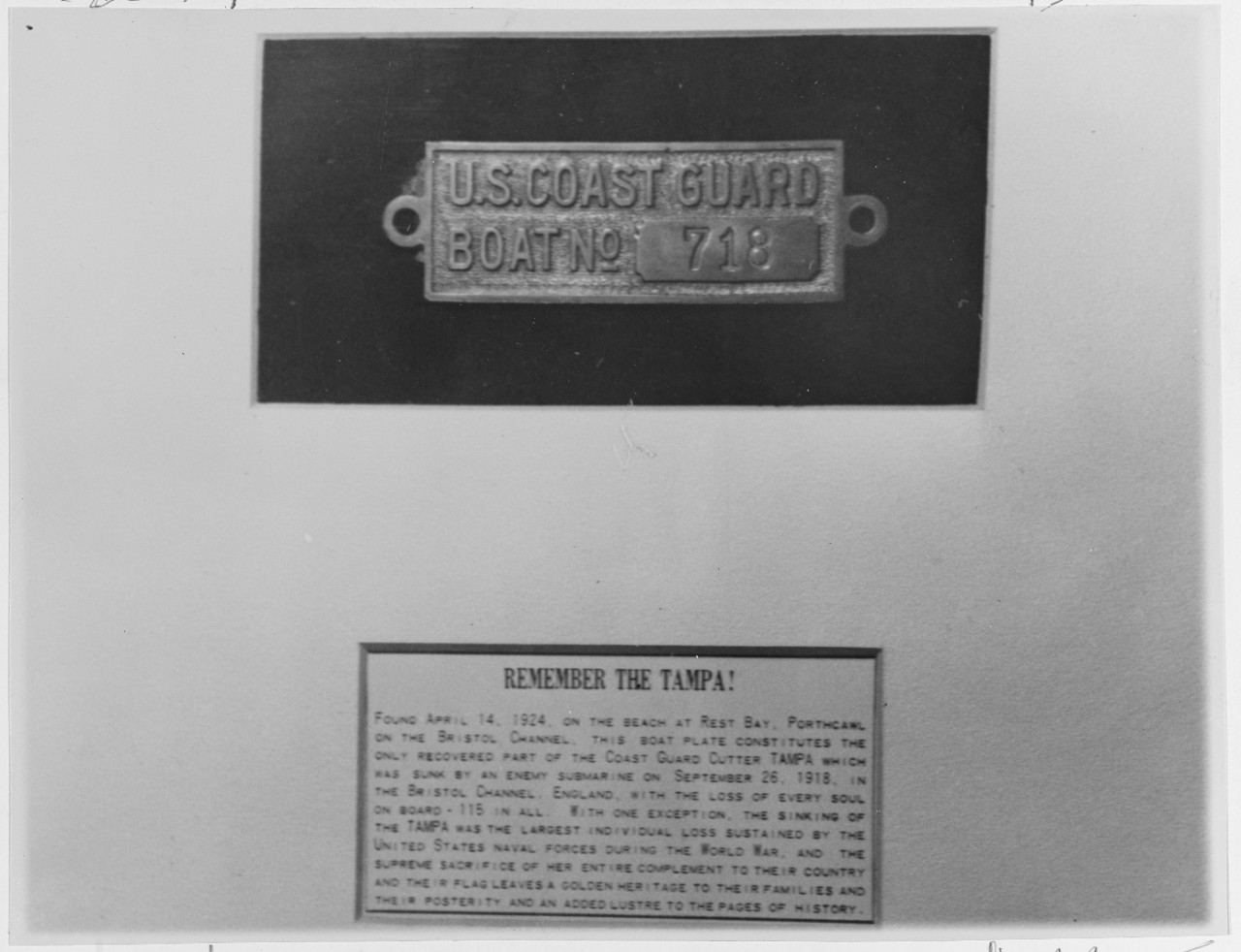
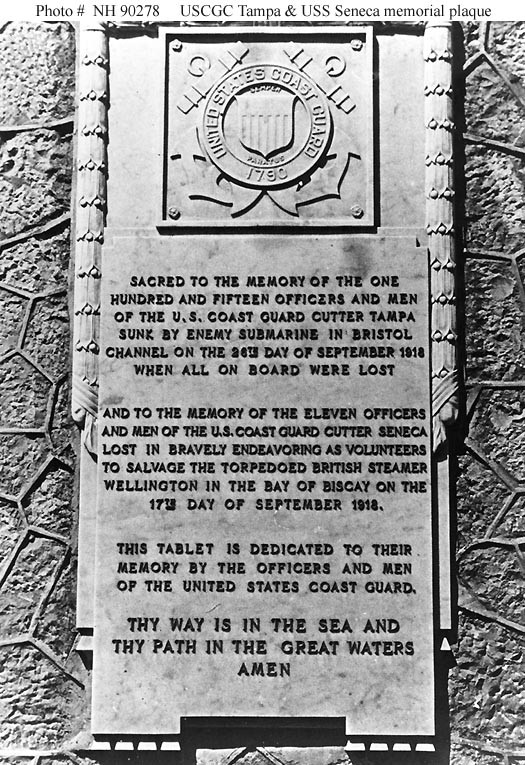
| Commanding Officers | Dates of Command |
| Capt. Aaron L. Gamble, RCS | 19 August 1912–10 October 1913 |
| Capt. Walker W. Joynes, RCS | 10 October 1913–24 November 1913 |
| Capt. Johnstone H. Quinan, RCS; | 24 November 1913–26 March 1914 |
| Capt. Bernard H. Camden, RCS | 26 March 1914–9 December 1915 |
| Capt. Charles Satterlee, USCG | 9 December 1915–26 September 1918 |
Christopher B. Havern Sr. with supplemental information provided by the USCG Historian’s Office
10 September 2018


